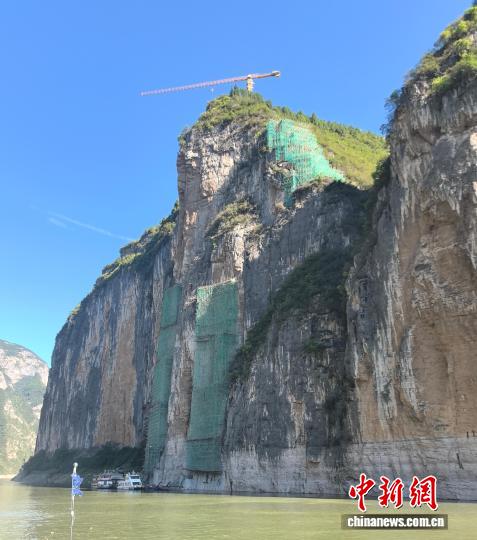On the right bank of the Qutang Gorge in the Yangtze River, a hidden danger looms—the Diao Zui unstable rock mass. This area is not only a critical section of the Yangtze River’s Golden Waterway but also the scenic backdrop featured on China’s fifth series of 10-yuan banknotes.
Behind this breathtaking landscape lies a massive unstable rock formation of 1.406 million cubic meters. If it were to collapse, the resulting waves would directly threaten the safety of the waterway, nearby docks, and the lives of over 3,000 people. A large-scale stabilization project is now underway to address this hazard.
The Peril Overhead: 1.4 Million Cubic Meters of Unstable Rock Threatening the Golden Waterway
At the entrance of Qutang Gorge, the river surges forward. Approximately one kilometer upstream on the right bank, a colossal unstable rock mass of 1.4 million cubic meters hangs precariously. The Diao Zui rock formation consists of 27 individual unstable sections, 50 fracture zones, and 17 isolated boulders. Among these, five exceptionally large slab-like unstable rock masses have a staggering volume, equivalent to stacking dozens of standard football fields 100 meters high.
Surveys indicate that while the overall rock mass is relatively stable, some sections are showing signs of instability. The consequences of a collapse would be catastrophic—initial waves could impact the Baidi City scenic area, the Fengjie Port passenger terminal, and the Yangtze River’s primary waterway, with estimated direct economic losses exceeding 300 million yuan.
“This is not only a crucial shipping route but also a core scenic area of the Three Gorges. Immediate action is imperative,” said an expert from the Chongqing Institute of Geology and Mineral Resources.
Since 2022, Fengjie County has implemented emergency monitoring, deploying 40 automated devices to track cracks and stress changes in real time. The stabilization project completed its design phase in March 2024 and officially commenced construction in October.
Today, workers tread carefully on the steep cliffs as drilling machines roar continuously.
“Surgical” Stabilization: Pioneering Techniques for a Critical Challenge
The danger of Diao Zui lies in its steep riverside face, with the lower section of the unstable rock mass less than 200 meters above the water. Even small falling rocks could cause significant damage to passing ships. Chongqing’s approach focuses on creating a precise aerial defense system.
The project manager explained that facing a near-vertical 258-meter cliff—equivalent to an 80-story building—the team developed a comprehensive stabilization plan involving rock removal, support structures, anchoring, horizontal tension cables, active protective netting, crack sealing, continuous monitoring, avoidance measures, and ecological restoration.
Three unconventional techniques are particularly crucial: a 165-meter suspended scaffold built in tiers with independent load-bearing systems; horizontal tension nets to secure the critical W4 rock mass; and an “aerial material corridor” to solve vertical transportation challenges, ensuring precise material delivery.
As of August 2025, the project is 47% complete, with 70% of the active protective netting installed and 100% of loose rock cleared by specialized climbers. The main structure is expected to be finished by year-end, fully stabilizing the massive rock formation.
The Economics of Prevention: 300 Million in Benefits Versus Investment
Protecting lives and the waterway far outweighs the costs. “The project requires an investment of 44.73 million yuan but will prevent direct economic losses of at least 300 million,” explained a local official.
This goes beyond simple cost savings. Successfully “locking down” the unstable rock mass ensures uninterrupted navigation on this vital waterway, prevents port closures and shipping disruptions, and safeguards the millions of annual visitors to the Baidi City-Qutang Gorge scenic area, maintaining the region’s tourism industry.
During construction, the team prioritized environmental protection alongside stabilization, carefully preserving and restoring vegetation to ensure the cliffs remain both secure and ecologically vibrant.
With the main project entering its final phase, this critical section of the Yangtze—known as the “Gateway to the Gorges”—will soon regain its majestic beauty while remaining secure for generations to come.




